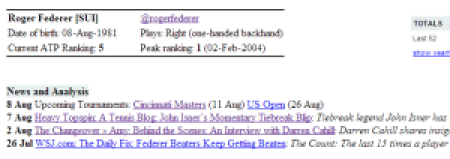When the US Open Women’s draw was released on Friday, things looked awfully bright for Caroline Wozniacki. With Maria Sharapova‘s withdrawal, Sara Errani became the #4 seed, meaning that one spot in the semis belonged to Errani–or, more likely, someone who knocked her off along the way.
But Wozniacki is no lock herself. 11 of her last 12 losses have come to players outside the top 20. She’ll have to do much better than that to take advantage of her position in the Errani quarter.
To find a dark horse for that semifinal spot, look no further than Wozniacki’s latest conqueror, Simona Halep. Halep crushed Petra Kvitova yesterday in New Haven, marking her fourth title of the year on three (!) different surfaces. In her last 38 matches, the only player to beat her in straight sets has been Serena Williams.
Halep’s path to the semifinal goes starts with Heather Watson and either Donna Vekic or Mariana Duque Marino, then a possible third-rounder with Maria Kirilenko, whom she has never played. Errani would be her fourth-round opponent if she lives up to her seeding, though that section is completely up for grabs. Wozniacki–who Halep beat on Friday in straight sets–is the presumptive quarterfinalist.
Strangely enough, Halep is one of the few players in the draw with a reason to fear Errani on hard courts. In Miami this year, the Italian routed her 6-1 6-0.
—
Yesterday, when Serena Williams was asked about her rivalry with Victoria Azarenka, she said, “I think the head-to-head is close.” It’s not: Serena has won 12 of their 15 meetings. While Vika has won two of the last three–including each of the last two on hard courts–the American won the ten before that.
Given Serena’s dominance over the rest of the WTA, one might reasonably ask whether an 80% winning percentage actually does constitute “close” for the world #1. Sure enough, there are few players who have topped that.
In her career, Serena has faced 42 different opponents at least five times. Only 13 of those have won one-quarter or more of their meetings, and only five of those remain active. To go even further, three of those five–Venus Williams, Nadia Petrova, and Francesca Schiavone–no longer figure to threaten Serena at all.
The remaining two players are Jelena Jankovic (4 wins in 10 meetings) and Samantha Stosur (3 wins in 9 meetings). Jankovic wouldn’t face Serena until the semifinals, and Stosur until the finals, even in the unlikely event either player made it that far.
Of course, there are good players who have met Serena fewer than five times, including her possible fourth-round opponent, Sloane Stephens. Of the 108 active players who have ever faced Williams, Sloane is one of only five who have won at least half of their meetings with her.
—
The three US women who qualified for the main draw pushed the total number of Americans on the women’s side to 19, the highest number since 2006. Between those qualifiers and a few long-shot wild cards, most of the 19 will be gone a week from now. But even accounting for plenty of attrition, the American force could continue to shine brighter than they have for nearly a decade.
Based on my draw forecast (which is in turn based on WTA rankings), we should expect to see between eight and nine US women in the second round. Eight wouldn’t be terribly impressive–that mark was reached in both 2009 and 2011, but nine would represent a step forward, however incremental. The last time nine or more American women reached the second round was when ten did so in 2005–and that accomplishment required 23 US players in the main draw.
My forecasts predict about four American women in the third round–equal to last year’s mark, and one short of 2011’s. But if the home favorites can score a couple of upsets and get six women into the round of 32, it would be the first time since 2004, when eight US women made it that far.
If the American women do make a strong showing, there’s an added bonus: It might help us ignore the plight of the American men.
